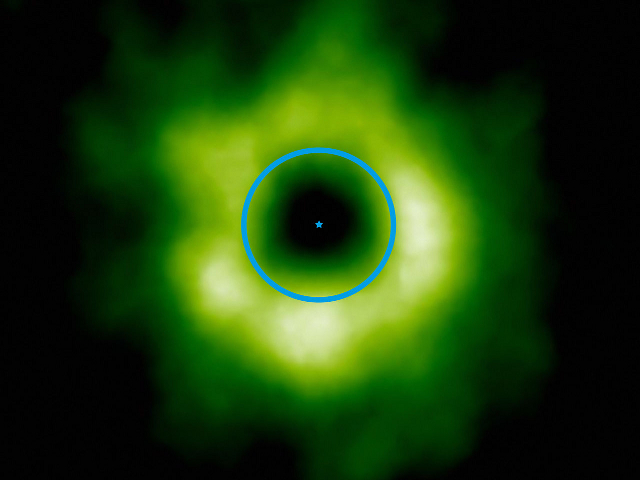The green is emission from a molecule revealing the location of carbon monoxide ice in a young star system. The blue line is the size of the orbit of Neptune. According to planet-formation models, the region where carbon monoxide freezes is exactly where this observation finds it.
Chunhua Qi and colleagues observed a disk around a newborn star, a disk that appears similar to what we think the Solar System looked like about 5 billion years ago. It surrounds a newborn star similar to the young Sun. They looked for light emissions that only occur where carbon monoxide is frozen. The observations discovered a ring of ice where theory predicted, roughly at the same distance Neptune is from the Sun. In the Solar System, that distance marks where large planets no longer form and where the realm of the comets and Pluto-like objects begins. This is the first observation of its kind, so it should help astronomers refine planetary formation models and understand the origins of prebiotic molecules—essential chemicals for life.
Snow lines are the distances from a star where different materials freeze; there are distinct snow lines for molecules such as water and ammonia. The analogy is obviously with mountains on Earth: as you ascend, the colder temperatures make snow more likely, even in summer, with a distinct transition where the temperature crosses 0°C. The important snow lines in planet formation theory are for water, carbon dioxide (CO2), and carbon monoxide (CO). Those distances help determine what kind of planetary body will form and how massive it can grow.
For example, in the Solar System, the water snow line is roughly at 3 astronomical units (AU), or 3 times the average distance between Earth and the Sun. That's in the Asteroid Belt, between the orbits of Mars (which is rocky and Earth-like) and Jupiter, which is composed mostly of hydrogen and is orbited by icy moons. According to planet formation theory, that division isn't arbitrary: the types of objects that formed on either side of the water snow line were distinct.
Additionally, snow lines mark places where planets can grow larger. Any water beyond its snow line will form ice crystals, which can interact with clumps of dust, stick together, and perhaps form a planetary object. Ice is typically stickier than rock or dust, so it could play a significant role in governing the sizes of planets that form near the snow line. Similar things apply to molecules in addition to water.
Carbon monoxide has a much lower freezing point than water, so its ice line in the Solar System is roughly 30 AU, about where Neptune orbits. Beyond that lies the Kuiper Belt, where Pluto, Eris, Quaoar, and other bodies of rock and ice lurk, along with many comets. A major advantage to looking for the CO snow line instead of its water equivalent is that it's simply easier to look for a transition far from the host star instead of close in. Even a high-resolution telescope would have difficulty pinpointing the water snow line.
However, CO ice is also interesting because it serves as a starting point for more complex organic molecules, specifically the prebiotic molecules found in comets. In the early Solar System, comets bombarded the inner planets including Earth, delivering these molecules and possibly assisting in the origin of life.
Yet another advantage to looking for the CO snow line instead of water is that there's another molecule that's easier to spot. That molecule, diazenylium (N2H+), only occurs in large volumes where CO ice exists. At warmer temperatures, carbon monoxide reacts with it, destroying it; once CO freezes, that reaction is slowed.
N2H+ emits light with wavelength of about 0.8 millimeters, so the researchers hunted for emission using the Atacama Large Millimeter/submillimeter Array (ALMA). They examined the young exoplanet system known as TW Hya, located roughly 178 light-years away from Earth. Prior observations showed the star to have a mass about 80 percent of the Sun's and an age of less than 10 million years. This system also has a protoplanetary disk, a region of dust, gas, and ice that could be the raw material for later planet formation. The dust disc extended out beyond 100 AU, with larger grains and richer gas content closer in. TW Hya is also interesting because the system is nearly "face on" to us, so we're viewing the protoplanetary disk as though from above.
The new observations with ALMA showed a division between a region with no N2H+ closer than about 28 to 31 AU, and plentiful emission farther from the star. That's exactly where the CO snow line would occur, according to planet formation models. That further cements TW Hya as a potential Solar System stand-in, providing additional tests for theories of planet formation.

